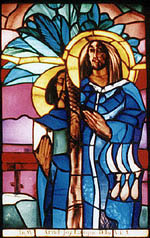|
CHRISTIAN APOSTLE BARTHOLOMEW
Greater things than these shall you see
The apostle Bartholomew was led to Christ in the region
of Galilee, possibly by the apostle Philip and his latter
ministry belongs more to the eastern churches than it does
to the western churches.
There is a very interesting personal description of
Bartholomew which says that He had black curly hair, white
skin, large eyes, a straight nose, hair that covered his
ears and a long grizzled middle
height beard. Bartholomew is said to have worn a white robe
with a purple stripe and a white cloak with four purple gems
at the corners. For twenty-six years he wore these and it is
said that they never grew old. In fact, It was also
reported, that his shoes lasted the same as his clothing.
Of Bartholomew, it is said that he prayed a hundred times a
day and a hundred times a night. It is also said that his
voice was like a trumpet, angels waited upon him and that he
was always cheerful and knew all languages. In the company
of the apostle Philip, the apostle Bartholomew went to Asia
Minor and labored in Hierapolis, near Laodicea and Colosse,
in what is modern day Turkey.
While in Hierapolis, it is said that the wife of the
Roman proconsul was healed by the apostles Philip and
Bartholomew, that she became a Christian and that her
husband ordered Philip and Bartholomew to be put to death by
crucifixion.
|

WORLD RELIGIONS COMPARED
WORLD
RELIGIONS CLIPART
WORLD
RELIGIONS HOME
CHRISTIAN HOME
CHRISTIAN APOSTLES |
Sadly, Philip was crucified, but Bartholomew escaped martyrdom, when
for some special reason, the magistrates caused him to be taken down
from the cross and dismissed. From there, Bartholomew went eastward
to India and then to greater Armenia.
A popular tradition among the Armenians is that the apostle Jude (Thaddaeus)
was the first to evangelize their region throughout the years of 43
to 66 AD and that the apostle Bartholomew joined him in 60 AD (eight
years before Bartholomew was martyred).
It is also said that Bartholomew carried with him a copy of the
apostle Matthew's Gospel. This copy was reported to be found at a
later time and a converted stoic philosopher by the name of
Pantaenus is said to have brought it to Alexandria.
Bartholomew is reported to have labored in the area around the south
end of the Caspian Sea, in the section that was then called Armenia.
The modern name of the district where he died is Azerbaijan and the
place of his death, called in New Testament times Albanopolis, is
now Derbend which is on the west coast of the Caspian Sea. The
apostle Bartholomew is said to have been martyred in the year 68 AD.

Symbol - Butcher Knife
The apostolic symbol of a knife resting on the Bible recalls
Bartholomew's life's work and his death at knifepoint. He is
specially remembered on August 24th each year. A very holy man, he
is said to have prayed 100 times a day and 100 times a night. He was
waited on by angels, and knew all languages. According to history,
Bartholomew was flayed alive, crucified and then beheaded.
He was an "Israelite indeed"
John 1:47

|